Plesiopterys
Plesiopterys (“plesio” meaning “near,” and “pterys” meaning “wing” or “pterygoid bone”) is an extinct genus of plesiosaur originating from the Posidonienschiefer of Holzmaden, Germany, and lived during the Early Jurassic period. It is thought to be the sister taxon to all other plesiosauroids including the Plesiosaurus, and is placed outside of the Plesiosauroidea group.[1] Plesiopterys wildi is the one known species within the genus, and is 220 centimeters long, or about 7.2 feet, and its body and skull are both relatively small. It possesses a unique combination of both primitive and derived characters, and is currently displayed at the State Museum of Natural History, Germany.[2]
| Plesiopterys Temporal range: Early Jurassic, | |
|---|---|
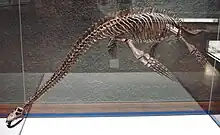 | |
| Skeletal reconstruction | |
| Scientific classification | |
| Domain: | Eukaryota |
| Kingdom: | Animalia |
| Phylum: | Chordata |
| Class: | Reptilia |
| Superorder: | †Sauropterygia |
| Order: | †Plesiosauria |
| Family: | †Cryptoclididae |
| Genus: | †Plesiopterys O'Keefe, 2004 |
| Type species | |
| Plesiopterys wildi O'Keefe, 2004 | |
| Synonyms | |
|
P. guilelmiimperatoris, Guilelmi imperatoris | |
Discovery
The Plesiopterys wildi specimen was discovered around August 1893 by a local slate dealer in the Haurr slate pit. This slate is from the lower division of the upper Lias, and the zone of the Posidonia Bronni Oppel’s. The slate dealer offered the specimen to the local Royal Museum of Natural History for sale, and H. W. Dames, a paleontologist, was commissioned by the government to inspect the specimen and give his opinions and analysis. At that time, the only plesiosaur fossils that had been discovered in Germany were small fragments or individual vertebrae, which made this specimen, in Dames’ words, a “first-rate showpiece.” The original owner of the specimen had already been preparing the specimen for three months in such a way that half of the skull was exposed on the underside. Coincidentally, another fantastically preserved specimen of Ichthyosaurus biscissus was uncovered around the same time, so the ruler of Germany at the time decided the two be inspected together. Additionally, he approved that Plesiopterys wildi be introduced into the scientific community as “Guilelmi imperatoris.” This term is no longer used, nor are the other synonyms, and Plesiopterys wildi is the correct name for this specimen. Because information about Plesiosaurs was extremely limited at the time, Dames requested to have relevant specimens sent to him by directors of several paleontological collections so that he could perform a proper inspection and description.[3]
Description
Plesiopterys wildi is a relatively short plesiosaur that is mounted at 220 cm with a relatively small head and body, its limbs and limb girdles being similar in proportion to other plesiosaurs. It has 39 neck vertebrae; by comparison, Plesiosaurus has 27 neck vertebrae, but because each individual vertebrae of Plesiopterys is shorter, it has a longer neck than Plesiosaurus, though its general morphology and proportions are more similar to Thalassiodracon. In addition to 39 cervical vertebrae, Plesiopterys also has 23 dorsal vertebrae, 3 sacral vertebrae and, and 41 caudal vertebrae.[2] Plesiopterys retains specialized grooves on the dorsal side of the pterygoid for attachment of the internal carotid artery, a feature that is not observed in Plesiosaurs.[2]
The SMNS 16812 specimen is thought to be a young adult due to the visible sutures between the centra and neural arch on the cervical vertebrae. Further confirmation of its adult age comes from the ossification states of other skeletal elements.[2]
Skull
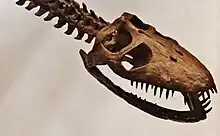
The skull of specimen SMNS 16812, while well preserved, has a rather crushed skull, with multiple skeletal elements having been broken off, rotated, or otherwise obliterated. On the premaxilla, four or five alveoli are present, along with five premaxillary teeth, which is a plesiomorphic feature for plesiosaurs. Its skull is intermediary between the more primitive Thalassiodracon and the more derived Plesiosaurus.[2]
The pterygoids are unique in that they possess grooves on the dorsal surface, and extend within the posterior interpterygoid vacuities and the pterygoid covering of the ventral surface of the basisphenoid. There has been some debate regarding the interpretations of the location of the suture between the vomer and the pterygoid, but it is most likely located at the anterior end of the anterior interpterygoid vacuity. This anterior interpterygoid vacuity is rather large, and is bigger than those in Thalassiodracon, Rhomaleosaurus, and Leptocleidus.[2] The large anterior interpterygoid vacuity is not a general autapomorphy.[1] The pterygoid possess thin flanges and extend within the posterior interpterygoid vacuities, and the pterygoid covering of the ventral surface of the basisphenoid.[2] Furthermore, there is no visible suture between the flanges and the quadrate rami of the pterygoids.[2] Dorsally, the thin pterygoid surface displays paired grooves that are oriented posterolateral to anteromedial. This feature is unlike those seen in any known plesiosaur, and is similar to the closed palate on nothosaurs.[2] The cultriform process of the parasphenoid divides the pterygoids, extending towards the posterior end of the anterior interpterygoid vacuity, and is rather narrow.[2] Unlike other early plesiosaurs, there is no evidence of a structure for articulation for a quadrate, but that may be due to degradation.[2]
The mandible retains a prominent mandibular ridge, unlike the rest of plesiosaurids, which have lost the feature.[2] Akin to Plesiosaurus, Plesiopterys has a simple and unreinforced lower jaw symphysis.[2] Unfortunately, the rest of the mandibular elements of SMNS 16812 are too crushed to identify, so no further significant features could be identified.[2]
The braincase of SMNS 16812 is similarly obstructed, being dislocated from the rest of the skull. However, the exoccipital/opisthotics, basioccipital, and the supraoccipital elements are similar to that seen in Thalassiodracon.[2]
Postcranial skeleton
The postcranium of Plesiopterys contains 39 cervical vertebrae, which is greater than the plesiomorphic number of about 30-32 cervical vertebrae. The neck length of Plesiopterys suggests that it is likely transitional in terms of neck morphology compared to Plesiosaurs.[2] The neural arches do not have zygosphene-zygantrum articulations and are shorter than the vertebral centra, which is a state shared with plesiosaurians. The centra themselves are about the same width and length. The humerus is also similar to the plesiosaurian type; it is angled so that the anterior end is angled for articulation with the radius, and the posterior end for the articulation with the ulna. This further suggests that it is in an adult stage.[2]
Classification
Plesiopterys wildi is a sister taxa to Plesiosauroidea.[2]
Paleoenvironment
The Plesiopterys wildi specimen SMNS 16812 (Stattliches Museum für Naturkunde, Stuttgart, Germany) was discovered in Posidonienshifer, an area near Holzmaden, Germany, and is from the Lower Toarcian.[2] This area is well known for fossil finds of sauropterygians, and is divided into four main zones: Suebian-Franconian, Yorkshire, Luxembourgian, and Norman. The zonation of the area can be used to interpret the distribution of plesiosaurs from the Early Jurassic, as each species is sorted into their respective zones.[1]
The Posidonienshifer, also known as the Posidonia Shale, has yielded a great number of specimens, most abundantly ichthyosaurs and plesiosaurians. Plesiopterys wildi is accompanied by a few other taxa found in the Holzmaden area, including M. brachypterygius and Hauffiosaurus.[4]
References
- Grossman, Franziska (2007). "The Taxonomic and Phylogenetic Position of the Plesiosauridia from the Lower Jurassic Posidonia Shale of South-West Germany". Palaeontology. 50 (3): 545–564. Bibcode:2007Palgy..50..545G. doi:10.1111/j.1475-4983.2007.00654.x. S2CID 130961209.
- O'Keefe, F. Robin (2004). "Preliminary Description and Phylogenetic Position of a New Plesiosaur (Reptilia: Sauropterygia) from the Toarcian of Holzmaden, Germany" (PDF). Journal of Paleontology. 78 (5): 973–988. doi:10.1666/0022-3360(2004)078<0973:PDAPPO>2.0.CO;2. S2CID 53590349.
- Dames, H. W. (1895). "Die Plesiosaurier der süddeutschen Liasformation". Abhandlungen der Königlichen Akademie der Wissenschaften zu Berlin. 2: 1–83.
- Vincent, Peggy; Allemand, Rémi; Taylor, Paul D.; Suan, Guillaume; Maxwell, Erin E. (2017). "New insights on the systematics, palaeoecology and palaeobiology of a plesiosaurian with soft tissue preservation from the Toarcian of Holzmaden, Germany". The Science of Nature. 104 (51): 51. Bibcode:2017SciNa.104...51V. doi:10.1007/s00114-017-1472-6. hdl:10141/622228. PMID 28578532. S2CID 253637625.

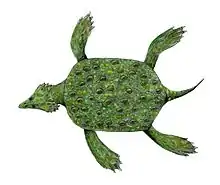
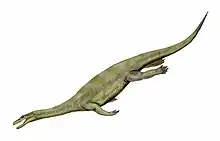


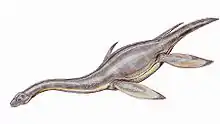
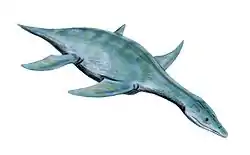
.png.webp)